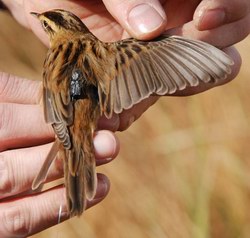The analysis of the Aquatic Warbler wintering habitats is in progress
Ogólnopolskie Liczenie Wodniczki 2009
24 kwietnia 2009Nowe stanowisko wodniczki na Lubelszczyźnie
17 czerwca 2009The research project “Habitat and threat assessment as a basis for the protection of the globally threatened Aquatic Warbler Acrocephalus paludicola in its wintering grounds in the Djoudj National Park area, Senegal” is being realised by Cosima Tegetmeyer (diploma landscape ecologist. University of Greifswald, Germany) at the only current known Aquatic Warbler wintering site located in the Djoudj area in Senegal. A landscape-ecological analysis of the habitats is carried out in this PhD study. The aim is to identify key factors of habitat choice of the Aquatic Warbler in Africa. The results will further help to develop adequate management measures for preservation of designated Aquatic Warbler habitats and to eventually find further wintering grounds in Western Africa.
The fieldwork takes place in close cooperation with the administration and the staff of the Biological Station of the Djoudj National Park. An important partner especially for organisational questions is Colonel Ibrahima Diop. Besides that, since 2009 the biologist Nina Seifert, working on a PhD-project on Baillion’s Crake at the same study sites, provided assistance in the Aquatic Warbler habitats research.

Radio taggeting.
Photo: Franziska Tanneberger
To determine the habitats and structures used by the Aquatic Warbler during its residence in the wintering grounds, the birds are caught with mist nets and observed by radio tagging. To designate the habitat of the Aquatic Warbler at the study sites, vegetation and other important site parameters primarily effecting the vegetation are investigated. In addition, food supply was studied in January 2009. A further important issue is the documentation of anthropogenic impacts like rice cultivation next to the protected National Park sites. This shall lead to a statement regarding the localisation, spatial extension and threat status of suitable Aquatic Warbler habitats in the Djoudj area.
Current results show that Aquatic Warblers occur in flooded lowlands with a dense vegetation of preferential Oryza longistaminata and Eleocharis mutata often mixed up with Sporobolus robustus with a maximal height of 1.5 m. These sites differ in salinity and water supply. One of the most important issues for further work will be to study the influence of the different vegetation types on the Aquatic Warbler’s habitat choice.
For more information contact: Cosima Tegetmeyer,
cosima.tegetmeyer@uni-greifswald.de

